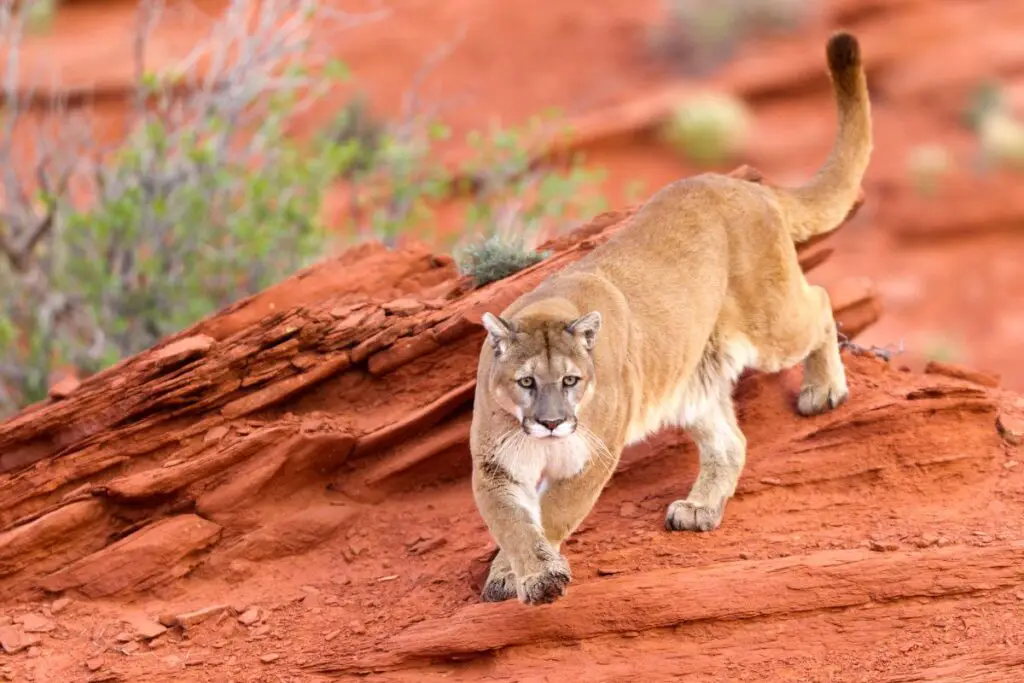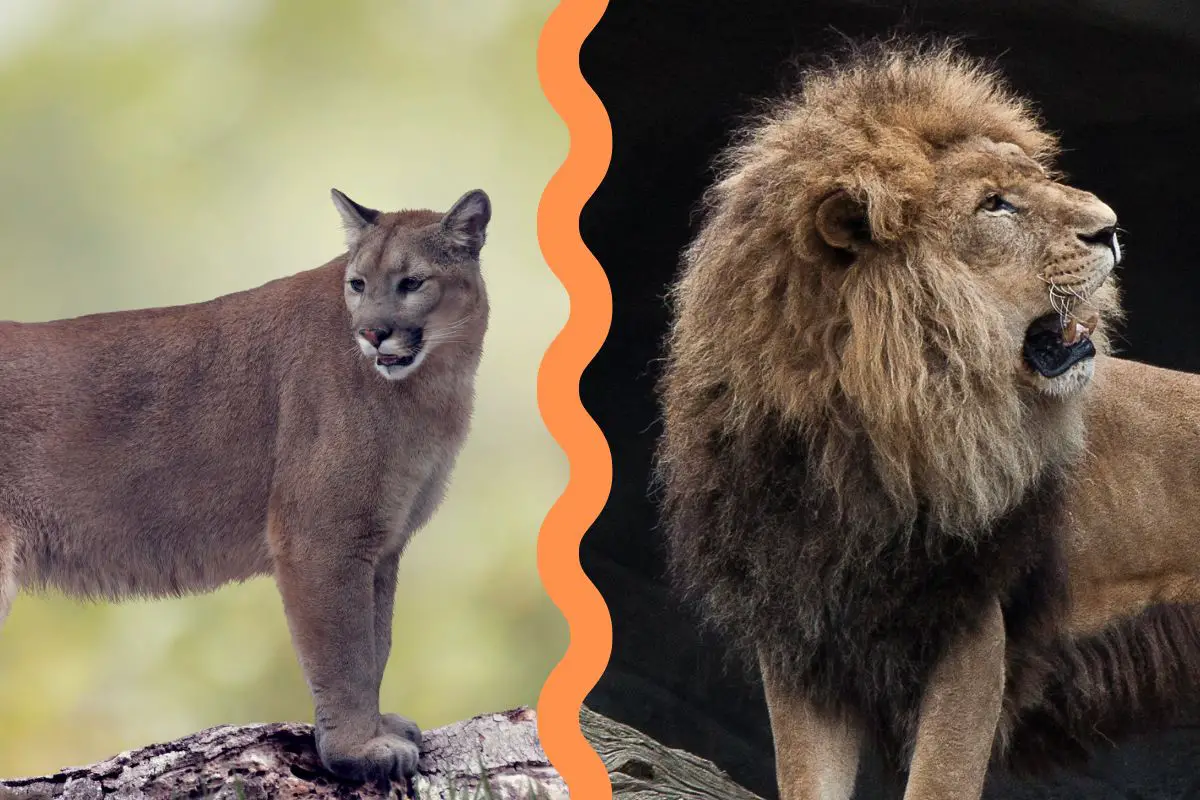Puma concolor, known in Canada and the western United States as the mountain lion and cougar, is able to thrive in a wide variety of different types of natural environments throughout North and South America.
Panthera leo, commonly known as the lion, roams the savannas and desert edges in Africa, with a small, endangered population in Asia. The larger group, collectively known as felines (family Felidae), includes around forty different species that are native to every continent except those of Australia and Antarctica.
Mountain lions and lions are both skilled hunters, who were revered by our ancestors for their strength, speed, and sheer ferocity.
Mountain Lion Versus Lion
Comparing the mountain lion vs the lion we find many similarities like their long muscular bodies built for speed and strength with rounded ears, rounded heads, and long tails. We also find many differences, such as their social interaction, choice of habitat, and size, with lions being more than three times the size of the mountain lion.
Are Lions Bigger Than Mountain Lions?
While these two species share a great number of similar attributes common to most members of the feline family, there are also many differences. If we were to see the two animals standing side by side, the first and most noticeable difference would be the size.
The lion is not the biggest of the big cats, that honor goes to the tiger. However, it is a massive beast coming in at a good five hundred pounds for the larger males and more than three hundred pounds for the largest of the females. Even though the lion is only the second largest cat species, it has earned the title of “king of the jungle”.
The mountain lion, also called puma or cougar, among other names, is the fourth largest cat in the world, coming in after the jaguar and before the leopard. The lion is larger than the mountain lion not only in weight but also in height, width, and length.
Male mountain lions usually weigh between one hundred and twenty pounds to one hundred and eighty pounds while the females are, on average, between seventy-five and one hundred and ten pounds. Mountain lions will reach lengths of eight feet long while lions often reach ten feet, counting their tails.
And finally, the lion stands between three and a half to four feet tall to the top of the shoulders, while the mountain lion stands two to three feet tall at the shoulders. Both species will vary in size based on geography.
Mountain lions that live near the equator are smaller than those who live nearer the poles. Similarly, lions in southern Africa are larger than those in east Africa and India.

Mountain Lion Vs Lion | Physical Characteristics
Size is not the only difference when it comes to the physical attributes of the mountain lion versus the lion. Male lions stand out from other large cat species, and from their female counterparts, for their broad head and bushy mane.
The “lion” part of the name mountain lion comes from their resemblance to the female lion. With most members of the feline family, especially the larger cat species, it is difficult to distinguish a male from a female as they both look similar in appearance.
The lion is an exception. The mane of the males makes them easy to tell apart from the females.
Another distinction of the lion is the dark tuft of hair at the end of its tail which conceals a “spur”, which is the final fused tailbone coming in succession from the spine. While other cat species like lynx, bobcats, and mountain lions will have a tail that is black on the tip, it is not near as bushy as that of the lion’s.
While the biggest tigers are bigger and stronger than the biggest lions, lions have the highest percentage of muscle mass compared to overall body weight. Exceptionally large mountain lions can reach in excess of two hundred pounds and also possess dense muscle mass.
Want to learn more about mountain lions? Check out Are Mountain Lions Dangerous
The Habitats of Mountain Lions and Lions
Mountain lions and lions vary greatly when it comes to geography, habitat, and range. Lions prefer an open landscape like savannas where there are plenty of grassy plains with few trees so that there is not a closed canopy as in a dense forest.
On the other hand, mountain lions make their homes in a wide variety of habitats ranging from dense forests to deserts and even open grasslands often around areas with steep canyons and escarpments with lots of brush for cover. They can be found from sea level up to an elevation of 19,000 ft.
Mountain Lion Vs Lion | Range
Mountain lions are found strictly in the western hemisphere of the Americas, while lions are found in the eastern hemisphere, mostly in Africa with some in Southeast Asia. These wild cats have the largest geographical range of wild animals in the Americas.
The historical range of the mountain lion once extended from the southern Yukon near the border of British Columbia to the southern parts of the Andes Mountains in Chile and Argentina. This range also extended laterally from the Pacific to the Atlantic coasts of the Americas.
While the mountain lion has historically roamed most of North and South America except for the northernmost reaches, their range has been greatly diminished especially in the eastern United States. Within the contiguous United States, their range has been cut by more than half.
Today, mountain lion presence in the Appalachian Mountain ranges, the coastal plains of the southeast, much of the Great Plains, and connecting areas is almost nonexistent. The historic range of lions included most of Africa except for the interior of the Sahara Desert and rainforests of the Congo River Basin, the Near East, and parts of southern Asia including India.
Today, lions inhabit only eight percent of their former range. The historical range of the lion began to diminish with the start of the Republic of Rome and continued throughout the existence of the Roman Empire and beyond, up to the present day.

Mountain Lion Vs Lion and Social Structure
Most cats, like the mountain lion, are solitary animals, preferring to live and hunt alone. Lions are once again the exception to the rule when it comes to feline anatomy and behavior, choosing to live in large groups known as prides.
Mountain lions will share their kills with others who are close to their home range without actually coming into contact with one another. Mountain lion kittens will stick around for a year or two but must disperse before the mother is ready to mate again or be in danger of being killed by their prospective male partners.
A lion pride can consist of as many as forty members but often averages around fifteen. Young male lions, after reaching maturity, will be ejected from the pride and become nomadic until such time as they become strong enough to take over a pride area, usually around five years of age.
How Different Are Their Diets?
As with many aspects of these animals, there are many differences and similarities when it comes to what they eat and their hunting styles. One of the similarities between mountain lions and lions is their preference for ungulates which roughly translates into “hoofed animal”.
For mountain lions, this means that animals such as elk, moose, mule deer, white-tailed deer, bighorn sheep, and mountain goats make up the largest percentage of their diet. Opportunistic feeders will also eat a variety of other animals when their favored meal is not available.
Like the mountain lion, the lion is a hypercarnivore, meaning that their diet consists of more than seventy percent meat. Lions prey on very large ungulates including zebra, wildebeest, African buffalo, giraffe, and antelope.
Lions will also prey on elephants who, like the rest of their prey, are herbivores however, they are not ungulates because they lack hooves. Although it is rare, lions will also feed on smaller prey if the need arises.
In times of extreme necessity, mountain lions and lions alike will feed on porcupines. How do mountain lions and lions eat porcupines? Very carefully!
Want to learn more about other types of animals? Check out Do Horses Lay Down
Mountain Lion Vs Lion: Their Hunting Techniques
Both the mountain lion and the lion are nocturnal and crepuscular. This means that they are most active around dusk and dawn and this is when they do most of their hunting.
Hunting in low light, or even in the dark, gives them a significant advantage over their prey thanks to their excellent night vision. This aids them in their “ambush-style” hunting.
Another advantage they share is their speed. Neither is known for their stamina, but both can sprint at astounding speeds. Both the mountain lion and the lion can reach speeds of fifty miles an hour.
Mountain lions stalk their kills through brush and trees, often attacking from above as they make their way across a rocky ledge. They will pounce on the back of an animal going straight for the throat.
Lions also stalk their prey but since they live in open, flat areas, it is usually from behind. They will more often than not cripple the animals before delivering the fatal blow, sometimes beginning to feed before the animals have died.
Another key difference in their hunting style is due to their social organization with lionesses hunting in teams within the pride. Males are not usually involved in group hunts unless their prey is exceptionally large.
Want to see the differences between other cats? Check out Bobcats Vs Mountain Lions
Final Thoughts
While the mountain lion and lion share many of the same qualities, they are most definitely two very distinct animals. Conservation is a concern for both animals. While exact numbers are unknown, there may be as little as 20,000 left of each.
While I have not seen a wild lion, I have seen lions in the zoo. That was an incredible experience. Seeing a mountain lion in the wild was also incredible, but also extremely scary! Either way, these cats demand respect and are a force to be reckoned with in the wild.
Additional Sources
Chisholm-Robinson, S. (1992). Mountain Lion: Puma, Panther, painter, Cougar. Roberts Rinehart Publishers.
Weston, C., & Taggart, C. (2011). Lion Country. Evans Mitchell Books.
- Hero Farm Dog Survives Epic Battle with Coyote Pack - December 9, 2024
- The 10-Minute Bedtime Routine That Changed My Dog’s Sleep Forever - November 29, 2024
- Creating a Safe Space for Nervous Pets: Your Guide to Pet-Friendly Havens - November 25, 2024

